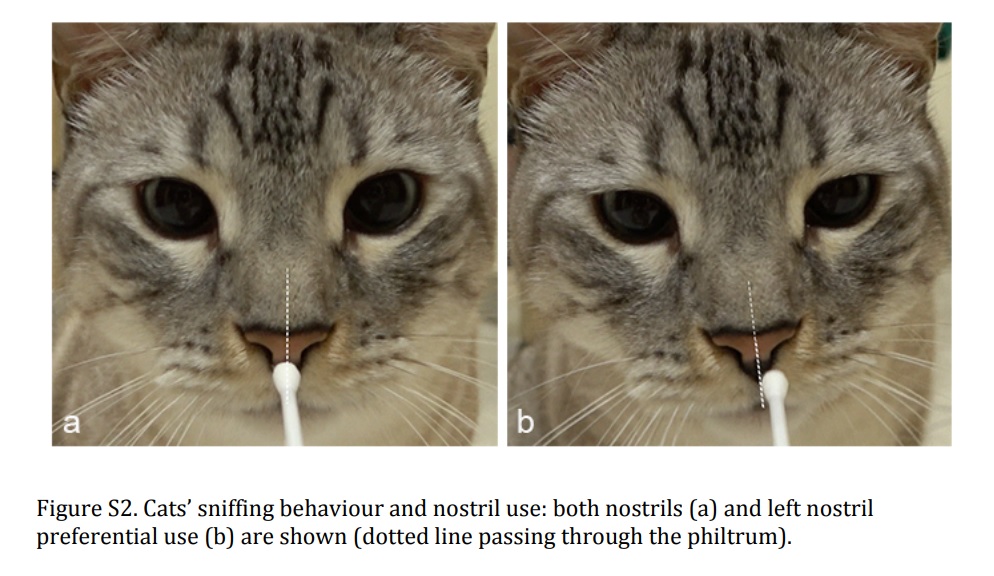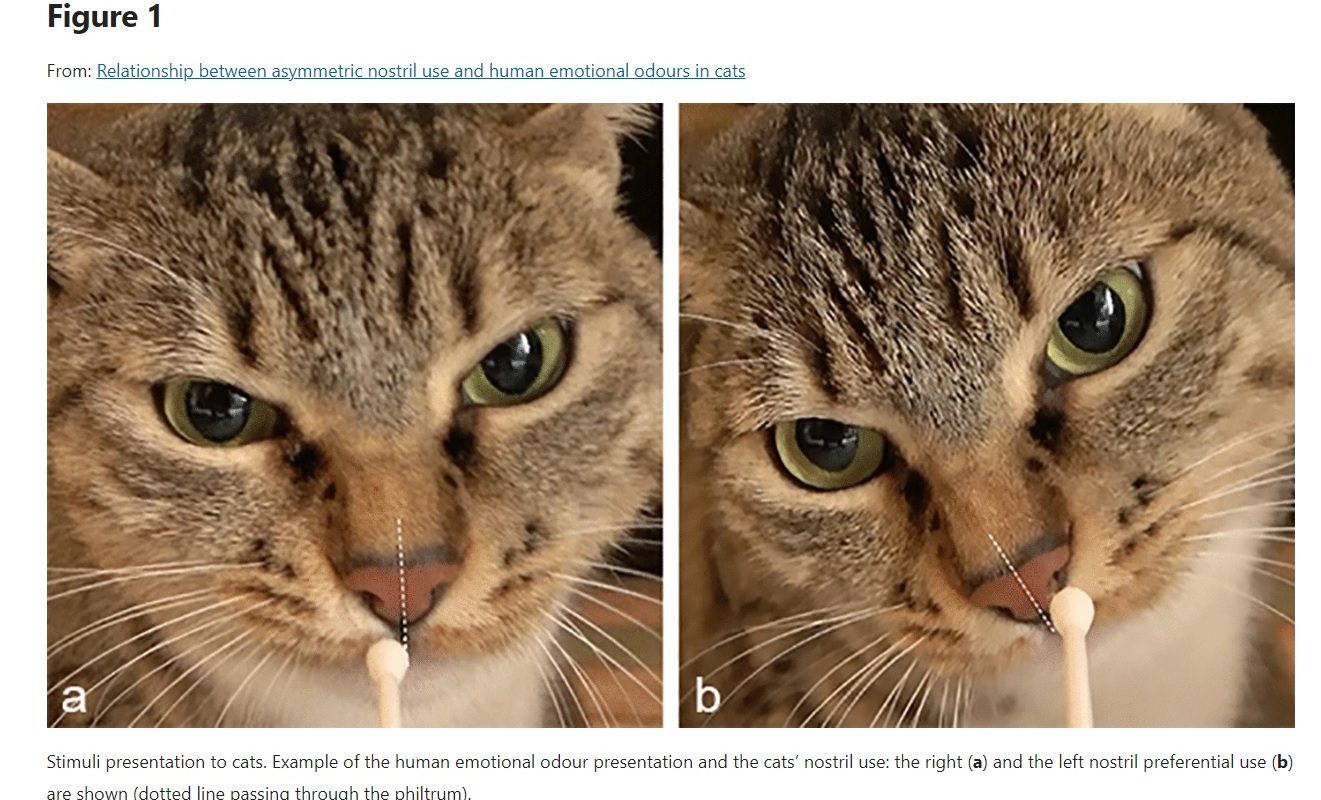A new study suggests yes – and which nostril they use may matter
Several studies over the last few years have looked at cat-human interactions – including how cats respond to petting by humans, whether they recognize their caretaker’s voice (seems like yes), and whether your cat finds your scent comforting when you’re away (not too much). Research has even suggested that cats can pick up on our body language and emotions, reading our cues when encountering a potentially scary object to determine whether or not that scary object is in fact safe.
Although cats do seem to be sensitive to our body language, tone of voice and facial expressions, we must always keep in mind that cats live in a different sensory world than we do. They have such a sensitive nose that it’s possible that they might be more in tune with other signs of emotion in humans, such as any changes in our body odor when stressed or afraid.
There have been multiple studies exploring how human emotions impact body odor (BO) – yes, there is a difference between how you smell when you’re experiencing fear or happiness. Humans can sniff a sweat sample from a stranger and identify at a rate greater than chance which emotion they were experiencing. No surprise, dogs are also able to discriminate the difference between human emotional odors. Perhaps more surprising, horses, cows and mice also can tell there’s a difference.
But what about cats? A recent study, “Relationship between asymmetric nostril use and human emotional odours in cats”, explored whether cats could tell the difference between human “happy sweat” and “fearful sweat.” The researchers who did the study also wanted to know whether cats would preferentially use a right or left nostril to do the sniffing, depending on the type of sweat.
Why would nostril side matter?
I’ve posted a few times about how cats can have a paw preference, and be left- or right-pawed (or ambidextrous). Paw preference is one example of brain lateralization – the tendency of each hemisphere of the brain to control different tasks. It turns out that the two hemispheres of the brain are also activated differently by different emotions. In general, the left hemisphere is responsible for the processing of positive emotions and approach behavior. The right hemisphere is involved in emotions like fear and anger, as well as exciting stimuli.
Some senses are contralateral (send signals to the opposite side of the brain). This is the case with vision, where information detected by the left eye is sent to the right side of the brain and vice versa. Olfaction primarily sends input to the same side of the brain (ipsilateral).
Dogs preferred to use their right nostril to sniff the stress smells of other dogs (right brain processing), but their left nostril to sniff the sweat of fearful and stressed humans (left brain processing). Horses preferred to use their right nostril when smelling adrenaline or the smell of another horse in estrus.
Do cats discriminate between human emotional odors?
To assess cats’ responses to human emotional odors, researchers tested 22 healthy pet cats (10 male, 12 female). All cats were living in homes, which is also where they were tested. Sweat samples were donated by three healthy men, who agreed to follow a specified diet and not use any scented products around the time that samples were collected. Samples were taken by placing multiple q-tips under the donor’s arm. Sweat donors watched 15-minute videos designed to elicit fear or happiness. A “physical stress” sample was taken after the donors ran on a treadmill for 15 minutes. A neutral BO sample was taken just after the donor took a shower.
Each cat was presented with the four scent samples for 45-seconds each, with 40-seconds in between samples. The cat was placed in front of the swab and allowed to approach and sniff the swabs. If no sniffing occurred within a minute, the next swab was presented. Video recordings were made so that the cats’ behaviors could be carefully assessed after data was collected. The person coding the videos did not know what emotional sample each cat was sniffing.
To determine which nostril the cat was using to sniff, video coders noted which side of the philtrum (the groove that delineates the sides of cats’ nose and lips) the q-tip was on.

Results
Cats showed more stress-related behaviors (backing away from the swab, ears flattened, swishing tail) when sniffing the fear odor compared to the neutral odor and physical stress odor. The more stressed behaviors a cat displayed, the more likely they were to sniff that odor with the right nostril (right side of the brain). Older cats were more likely to use their left nostril in general, regardless of the odor.
Do cats have a preferred nostril for sniffing?
When cats were stressed, and smelled body odor that was taken from a fearful human, they were more likely to use their right nostril to investigate that odor. The predominant use of the right nostril for sniffing relates to the right hemisphere’s known relationship with processing arousal and emotions like fear.
Although cats’ behavior and sniffing did not differ between happiness, physical stress, and the neutral BO sample, this study does support that cats can discriminate olfactory cues related to human fear. (Yes – next time you’re thinking of getting your cat into a cat carrier and your heart is pounding – your cat may pick up on your fear! But read more about helping your cat love the cat carrier here!). This study adds to our knowledge of the complexities of the cat-human relationship. Yes, cats have adapted to perceive human behavior and emotions – in ways we possibly hadn’t even considered!
References
D’Aniello, B., Semin, G. R., Alterisio, A., Aria, M., & Scandurra, A. (2018). Interspecies transmission of emotional information via chemosignals: from humans to dogs (Canis lupus familiaris). Animal cognition, 21, 67-78.
d’Ingeo, S., Siniscalchi, M., Straziota, V., Ventriglia, G., Sasso, R., & Quaranta, A. (2023). Relationship between asymmetric nostril use and human emotional odours in cats. Scientific Reports, 13(1), 10982.
Jardat, P., Destrez, A., Damon, F., Menard–Peroy, Z., Parias, C., Barrière, P., … & Lansade, L. (2023). Horses discriminate human body odors between fear and joy contexts in a habituation-discrimination protocol. Scientific Reports, 13(1), 3285.
Merola, I., Lazzaroni, M., Marshall-Pescini, S., & Prato-Previde, E. (2015). Social referencing and cat–human communication. Animal cognition, 18, 639-648.
Semin, G. R., Scandurra, A., Baragli, P., Lanatà, A., & D’Aniello, B. (2019). Inter-and intra-species communication of emotion: chemosignals as the neglected medium. Animals, 9(11), 887.
Siniscalchi, M., d’Ingeo, S., & Quaranta, A. (2021). Lateralized emotional functioning in domestic animals. Applied Animal Behaviour Science, 237, 105282.



